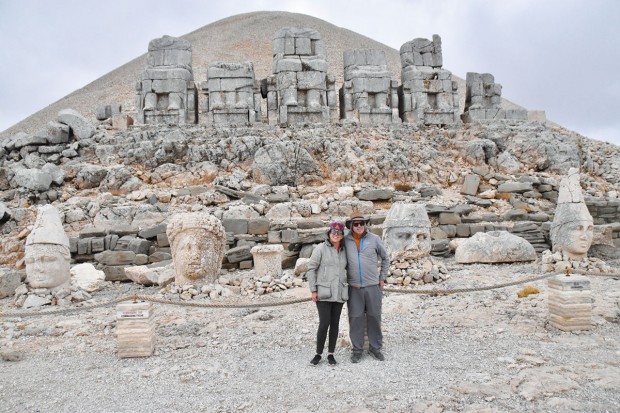Turkey: Journey through a Crucible of Cultures

It was an epic sojourn through ancient history. Turkey is the birthplace of Roman kings, Trojan warriors, Sufi saints, and Old Testament prophets; it was the home of the Apostles John and Paul and the Virgin Mary. This crossroad of cultures straddles Europe and Asia and is, in many ways, the cradle of modern civilization.
Little wonder, then, that when Antonio and Alexia Benavides were invited to join a tour led by the Turkish geologist Dr. Pinar Oya Yilmaz – a dear friend to Antonio’s sister Marita Benavides – naturally they jumped at the chance.
“It was a once-in-a-lifetime experience to go on the trip, and our friend had been organizing the itinerary with so much love and care for over a year,” said Alexia. Oya, as her friends know her, retired two years ago from her position as a high-level Exxon executive, and had meticulously planned the trip for herself and her best friends. In all there were nine in the group that traveled together, plus a local driver and guide.
In preparing the itinerary, Oya showcased a bedazzling window into Turkish culture. She spared no effort to feature the very best of Turkish cuisine, arranging special seatings and tastings in some of the finest restaurants. She included plenty of time for rug and silk and ceramic shopping and haggling fun. Of course, being a geologist, she included an overview of Turkey’s jaw-dropping geology, with spectacular formations and sites displaying every era dating back to the Jurassic.
After a nonstop flight from Houston, the journey began in Istanbul, as have many journeys over the millennia – although under the Greeks and then the Romans, it was known as Byzantium (660 B.C.-196 A.D.); and under the Eastern Orthodox Christians, it became Constantinople (330 A.D.) before the conquest by the Ottoman army led by Sultan Mehmed II in 1453.
“This is the point at which East meets West,” said Antonio. “Obviously I’m fascinated by the history and geopolitics of Turkey, which has been invaded since the beginning of mankind by every kind of civilization and world power.” At the same time, he was surprised at the extent of modern infrastructure, equal to any contemporary metropolis, Turkey being one of the world’s top 20 economies.
It was Antonio’s first time to Turkey, and although Alexia had been to Istanbul once, it was with her parents, 30 years ago, and that had been on the European side of the city. This time they would stay on the Asian side of the city, where Oya’s apartment was. After three days in Istanbul, they would set off for Eastern Turkey – the “fairy castles” and underground cities of Cappadocia, the Biblical city of Antioch, and other ancient cities all the way to the border with Syria.
But first there was Istanbul to explore, and that was an endless source of wonder in itself.
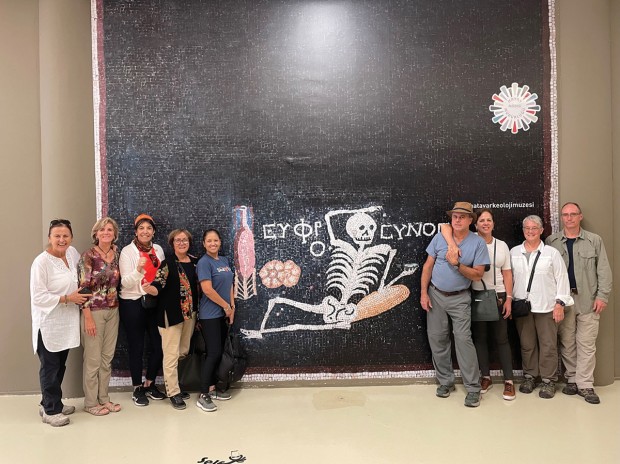
“You only live once,” reads the inscription on a mosaic from the Roman Empire in the Zeugma Mosaic Museum, the world's largest, in the town of Gaziantep, Turkey,
Beginning from their home base in the up-and-coming Eastern neighborhood of Moda, they enjoyed a ferry ride across the Bosphorus, docking at the bustling Eminonu pier. From there, they made their way to the fragrant 16th century Spice Market, and the cavernous Grand Bazaar, shopping to their hearts’ content before continuing on to Sultanahmet, the Old City, and to some of the world’s most stunning architecture: the Blue Mosque, the Hagia Sophia, Topkapi Palace, and the Basilica Cistern.
The Grand Bazaar, built in the 1400s, is one of the largest and oldest covered markets in the world, with 61 covered streets and some 4,000 shops – often called the world’s oldest shopping mall. The vibrancy of the city markets, in an area that was a hub of commerce for millennia, was what most impressed Antonio, who recalled that the Silk Road ended here in Istanbul, bringing untold exotic treasures from the Far East for more than 1,500 years.
Alexia was surprised at the number of high-end jewelry stores she saw in the Bazaar.
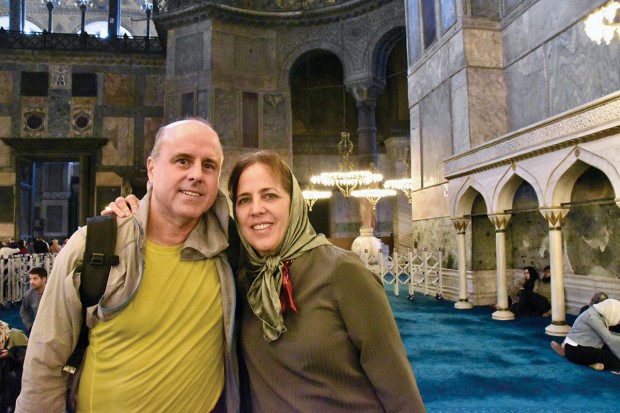
Antonio with Alexia, who like all women must don a scarf to enter a mosque, in this case the sixth-century Hagia Sofia – the largest cathedral in the world for nearly a thousand years, now converted to a mosque.
“I did not expect an open market like that to have all those precious pieces of jewelry being sold: emeralds, gold, diamonds,” she said. “The whole window was just full of gold… and then the next one… the sparkle was pretty impressive.”
Finally they headed for Sultanahmet, the ancient walled city, where they saw the nearly 1,500-year-old Hagia Sophia, the world’s largest cathedral for nearly a thousand years; the magnificent Blue Mosque, with its blue-tiled interior dome and its exquisite Ottoman architecture; and the remains of Byzantine Hippodrome, a pleasant walkway that served during Roman times as an arena for chariot races and other entertainment.
There in the ancient city they descended to see one of its most impressive sights: Yerebatan Sarayi, or the Basilica Cistern, whose name literally means “sunken palace.” A basilica, built during the third and fourth centuries, once stood here and was a stunning work of architecture in itself. In the sixth century, Emperor Justinian I built the cistern, according to ancient texts, on the backs of 7,000 slaves, many of whom died. The cistern was the water source for the nearby Topkapi Palace complex.
The forest of marble columns and ornate stonework remains intact, and their reflections shimmer on the water-covered floor. Sculptures abound, most unforgettably two massive Medusa heads – one upside down, and one on its side, both held firmly in place under massive marble columns – perhaps, as tourist guides say, to protect passersby from their evil gaze.
Alexia was stunned to learn the extent of the waterworks engineered during Roman times, with hot water and rooms heated with steam – even the floors were heated. “It was just mind-boggling, the things that were done in ancient times,” she remarked.
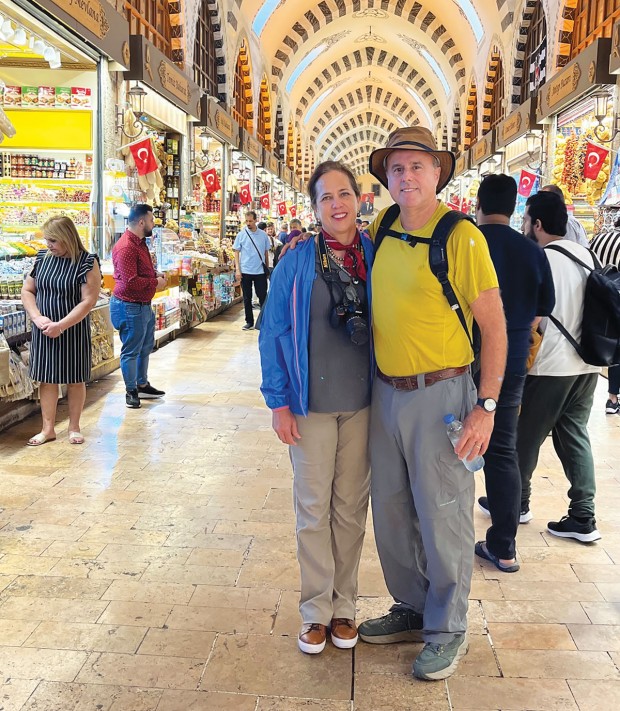
Alexia and Antonio take a break from their shopping in the Grand Bazaar, considered by many to be the world's oldest shopping mall.
On their fourth day they flew to Sanliurfa, also known as Urfa, a portal to the ancient past that defies the imagination. Urfa lies in the eastern part of Turkey, near the border with Syria. Here in this sacred city that was part of the ancient kingdom of Babylon, the prophet Abraham, Father of Judaism, Christianity, and Islam, is said to have been born in a cave that has become a pilgrimage site for thousands. Every day people remove their shoes, don headscarves, and line up to enter the cave. Alexia saw people weeping with emotion and filling bottles with the holy water from the pool.
Abraham’s Cave is on the grounds of Golbasi Park, known for its historic mosques and gardens. Here, according to legend, the Mesopotamian King Nimrod threw Abraham into a fire as punishment for refusing to worship idols. But the prophet was saved when the fire turned to water, and the firewood turned into goldfish whose legendary descendants swim happily in Abraham’s Lake.
Six miles outside the city lie the remains of a Neolithic site believed to be the world’s oldest known temple: the amazing Gobekli Tepe, built some 11,000 years ago – 6,000 years before Stonehenge, and before metal tools, the wheel, or even pottery, these builders arranged and carved giant stone pillars, some up to 16 feet tall, with elaborate and lifelike figures of foxes, scorpions, lions, vultures, and other animals.
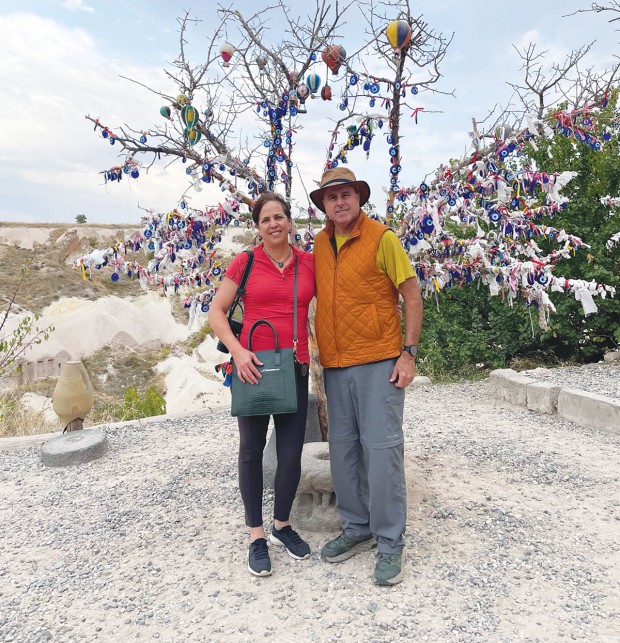
Alexia and Antonio pause from their travels in front of a tree covered in the traditional Turkish Nazar Boncuk - popularly known as the “Evil Eye,” though the intention is to ward off bad energy and evil intentions from others.
“It shows a really advanced level of culture for them to have been able to build that such a long time ago,” said Alexia, still marveling at the sight.
The next day they headed to the ancient city of Harran, once one of the most important cities of Northern Mesopotamia. Founded around 5,000 years ago, Harran is famous for its kümbets, tall adobe beehive houses, designed to manage the sweltering desert heat. Occupied over the centuries by the Babylonians, Assyrians, Hittites, Persians, the Alexandrian Empire, Romans, Byzantines, and Seljuks, among others, the city served as the capital of Islam for a time, and was home to one of the world’s oldest universities. It was raided in 1028 by the Crusaders, but it was rebuilt; however, in 1260, it was sacked and nearly destroyed by the grandson of Genghis Khan. The city continues to this day as a small village, mainly sustained by tourism.
“We were so close to the Syrian border, we could see the Syrian flag – that was a little bit of an adrenaline rush,” said Antonio. Other than that, the border seemed amazingly “uneventful,” he said.
But more incredible forays into ancient history awaited. Three hours north of Urfa, on one of the tallest peaks of the Taurus Mountains, lies a UNESCO World Heritage Site atop Mount Nemrut, home to a 2,000-year-old tomb and monument to a king who declared himself a god. There King Antiochus I of Commagene built three-story statues of himself, flanked by two lions, two eagles, and a variety of deities reflecting his Greek and Iranian heritage. Originally the statues were seated and inscribed with the names of each god. Apparently, the statues fell victim to vandalism at some point, and the heads lie scattered about as an eerie reminder of the vanity of human glory.
The pattern of damage to the heads – notably the smashing of noses – suggests that they were deliberately damaged by iconoclasts, Oya told the group. Next the group headed to Gaziantep, a city awarded the title of Creative City of Gastronomy by UNESCO in 2015. And gastronomy was at the top of the group’s agenda. With more than 30 varieties of kebabs, 20 different types of pastries, 30 types of soup, 50 varieties of vegetable dishes – the challenge was to have a representative sample.
The city is famous for its pistachios, harvested young and ground fresh to make what has been called the world’s best baklava. Their unforgettable dinner was at the Gaziantep Hisvahan Hotel, which is built literally on top of the archaeological site that was discovered while preparing for construction, as often occurs in Turkey. Now the restaurant and hotel’s glass floors and walkways allow viewers to peer down into the remains of a caravanserai – a roadside inn for travelers along the Silk Road.
The next day it was time to witness Gaziantep’s main attraction: the world’s largest mosaic museum. The Zeugma Mosaic Museum was created to house the abundance of fine Roman mosaics that were discovered during the damming of the nearby Euphrates River. Among the 1,700 square meters of mosaics was the enigmatic Gypsy Girl Mosaic. Called the “Turkish Mona Lisa,” the girl’s eyes have the uncanny ability to follow a viewer from place to place.
“The story of that mosaic is incredible,” said Antonio. “Her eyes follow you all over the exhibit.
“All the world powers have come into Turkey and looted everything, you know, starting with the Crusaders. So the mosaic ended up in Bowling Green State University in Ohio in 1965. And they had to shake every level of government to get it back.”
The mosaic, which is made of 12 separate panels, was finally returned to Turkey and reassembled, opening to the public in 2018. The image is widely featured in travel advertisements, including in Turkish Airlines’ magazine.
The Gypsy Girl was only the most memorable of a huge and spectacular collection. “These people really knew their trade, because they were absolutely fantastic,” said Antonio. One of the group’s favorites was of a cheerful skeleton, with a Greek inscription that translated to something like “Enjoy life because tomorrow you’ll be like this.”
“We had a lot of fun with that one,” said Antonio.
The next day they headed to Antioch, where they stayed at the unforgettable Museum Hotel, also built over an archaeological site.
“So you’re checking into your room and you look down and you see all these villas and mosaics and how the Romans heated their houses through the floor with steam. Incredible,” said Antonio. “It's a five-star hotel, but it’s unlike any other I’ve ever stayed at in the world.”
Here in this Biblical city they went to see the UNESCO-designated St. Pierre Church, believed to be the founding site of all Christianity and the cave where St. Peter first preached the gospel. The cave was later turned into a church, with its facade carved into the mountainside.
In the afternoon the group had a special visit, organized by a friend of Oya, to the Antakya Orthodox Church, one of the oldest operating churches in the world. There they were personally greeted by Father Dimitri, who welcomed the group warmly and told them the fascinating story of this Byzantine church that still operates today.
“I was surprised to hear Father Dimitri is married and has kids, and has also a very normal or ‘secular’ life on top of his religious responsibilities,” commented Alexia.
The day came to a marvelous close with dinner at the renowned Konak restaurant, where Oya was able to secure reservations at the high terrace, usually reserved for the Governor.

Alexia, Oya, and Oya’s friend, Yarasel Cruz, stop for a pose at a tourist stop. “Kapadokya” is the Turkish spelling of Cappadocia, and the characteristic cave houses hollowed from the soft volcanic stone can be seen on a hill in the background. The region's original inhabitants hollowed out the formations to construct homes, churches, stables, and even entire underground cities; some are still inhabited, and others have become museums.
Finally on the last leg of their trip they drove five hours to Cappadocia, famed for its spectacular geological formations known fancifully as “fairy castles.” They were to have taken a balloon ride over the whole spectacle as is customary but sadly two Spanish tourists had died the day before in a ballooning accident so on their only day in Cappadocia, there were no balloon rides.
Nevertheless, Cappadocia revealed its magic to them in multiple ways. First, they took a tour through the astonishing Kaymakli Underground City, built in the 8th and 7th centuries BC to offer protection from foreign invaders. The four-story underground city had a holding capacity of 3,500 people. It was used first to escape various waves of invaders, including the Mongols, and then, years later, for several centuries throughout the Arab-Byzantine wars. Carved into the soft volcanic rock of the region, the city was continually expanded to include stables, homes, storage areas, a communal kitchen, and a church.
Turkey’s strategic location made it a target for wave after wave of invasions, and Kaymakli was just one of several underground cities where the people took refuge; another, called Derinkuyu, extends to more than 85 meters below the Earth’s surface, and includes 18 levels of tunnels.
“We just descended four levels into the cave through narrow tunnels, and that was enough for me,” said Alexia. “Even though there were places for animals, and even wineries in the system, I think it must have been really difficult to spend more than three days down there.”
Cappadocia’s landscape itself defies description. More than 7,000 square miles, it is home to over 200 underground cities that have been carved into the rock over the millennia; in some areas, layers of soft pink and yellow hued dune-like hills come to a sharp point. The rocks near the Cappadocia city of Göreme eroded into hundreds of spectacular pillars and minaret-like forms.
As Oya explained it, the Cappadocia region is underlain by soft sedimentary rocks formed in lakes and streams, interspersed with hard ignimbrite deposits that erupted from ancient volcanoes from nine to three million years ago, during the late Miocene to Pliocene epochs. The people of the region carved out houses, churches, and monasteries from the soft rock formations and some are still inhabited to this day.
The city of Göreme became a monastic center in 300–1200 AD, with the first settlement period dating back to the Roman period. The group paid a visit to the Göreme Open Air Museum, one of the most famous sites in central Turkey. The complex contains more than 30 churches and chapels carved into the stone, some of which contain superb examples of Byzantine frescoes dating as far back as the ninth century.
“There’s just so much culture that for us who grew up in a Western environment, it’s just not something you’re aware of,” said Alexia. “In Houston, you dig down and you find clay. Over there, you dig and you find a 10 million-year-old fossil, or a 10,000-year-old archeological site. It’s a country so rich in history that you feel very humbled by it.”
For Antonio, the trip really opened his eyes to the depth of human history. “You learn to really appreciate ancient cultures,” he said, “and how insignificant our history of 200 years is compared to those cultures.”
Editor’s note: Buzz travel columnist Tracy L. Barnett is a Lowell Thomas travel journalism award winner and longtime travel and environmental writer. Email her at [email protected] to share your own travel tales.
Want more buzz like this? Sign up for our Morning Buzz emails.
To leave a comment, please log in or create an account with The Buzz Magazines, Disqus, Facebook, or Twitter. Or you may post as a guest.


